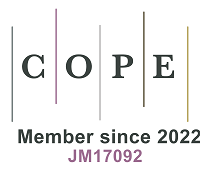REFERENCES
1. U.S. Bureau of Labor Statistics. Labor force statistics from the current population survey. Household data annual averages. 11. Employed persons by detailed occupation, sex, race and hispanic or latino ethnicity. https://www.bls.gov/cps/cpsaat11.htm. (accessed 14 Oct 2025).
2. Helm, J. S.; Nishioka, M.; Brody, J. G.; Rudel, R. A.; Dodson, R. E. Measurement of endocrine disrupting and asthma-associated chemicals in hair products used by Black women. Environ. Res. 2018, 165, 448-58.
3. James-Todd, T.; Connolly, L.; Preston, E. V.; et al. Hormonal activity in commonly used Black hair care products: evaluating hormone disruption as a plausible contribution to health disparities. J. Expo. Sci. Environ. Epidemiol. 2021, 31, 476-86.
4. Zhang, Y.; Mustieles, V.; Williams, P. L.; et al. Parental preconception exposure to phenol and phthalate mixtures and the risk of preterm birth. Environ. Int. 2021, 151, 106440.
5. Land, K. L.; Miller, F. G.; Fugate, A. C.; Hannon, P. R. The effects of endocrine-disrupting chemicals on ovarian- and ovulation-related fertility outcomes. Mol. Reprod. Dev. 2022, 89, 608-31.
6. Pan, J.; Liu, P.; Yu, X.; Zhang, Z.; Liu, J. The adverse role of endocrine disrupting chemicals in the reproductive system. Front. Endocrinol. 2023, 14, 1324993.
7. Kolena, B.; Petrovičová, I.; Šidlovská, M.; et al. Occupational phthalate exposure and health outcomes among hairdressing apprentices. Hum. Exp. Toxicol. 2017, 36, 1100-12.
8. Molinari, F.; Franco, G. A.; Tranchida, N.; Di Paola, R.; Cordaro, M. Molecular mechanism of action of endocrine-disrupting chemicals on the respiratory system. Int. J. Mol. Sci. 2024, 25, 12540.
9. Deng, C.; Jiang, Y.; Lin, Y.; et al. Potential effects of endocrine-disrupting chemicals on preserved ratio impaired spirometry revealed by five different approaches. Ecotoxicol. Environ. Saf. 2025, 302, 118701.
10. Özel, F.; Rüegg, J. Exposure to endocrine-disrupting chemicals and implications for neurodevelopment. Dev. Med. Child. Neurol. 2023, 65, 1005-11.
11. Yesildemir, O.; Celik, M. N. Association between pre- and postnatal exposure to endocrine-disrupting chemicals and birth and neurodevelopmental outcomes: an extensive review. Clin. Exp. Pediatr. 2024, 67, 328-46.
12. O’Shaughnessy, K. L.; Fischer, F.; Zenclussen, A. C. Perinatal exposure to endocrine disrupting chemicals and neurodevelopment: how articles of daily use influence the development of our children. Best. Pract. Res. Clin. Endocrinol. Metab. 2021, 35, 101568.
13. Boyle, M. D.; Kavi, L. K.; Louis, L. M.; et al. Occupational exposures to phthalates among Black and Latina U.S. hairdressers serving an ethnically diverse clientele: a pilot study. Environ. Sci. Technol. 2021, 55, 8128-38.
14. Louis, L. M.; Kavi, L. K.; Boyle, M.; et al. Biomonitoring of volatile organic compounds (VOCs) among hairdressers in salons primarily serving women of color: a pilot study. Environ. Int. 2021, 154, 106655.
15. Moradi, M.; Hopke, P.; Hadei, M.; et al. Exposure to BTEX in beauty salons: biomonitoring, urinary excretion, clinical symptoms, and health risk assessments. Environ. Monit. Assess. 2019, 191, 286.
16. Arfaeinia, H.; Ramavandi, B.; Yousefzadeh, S.; et al. Urinary level of un-metabolized parabens in women working in beauty salons. Environ. Res. 2021, 200, 111771.
17. Porras, S. P.; Hartonen, M.; Ylinen, K.; Tornaeus, J.; Tuomi, T.; Santonen, T. Environmental and occupational exposure to resorcinol in Finland. Toxicol. Lett. 2018, 298, 125-33.
18. Arfaeinia, H.; Dobaradaran, S.; Mahmoodi, M.; Farjadfard, S.; Tahmasbizadeh, M.; Fazlzadeh, M. Urinary profile of PAHs and related compounds in women working in beauty salons. Sci. Total. Environ. 2022, 851, 158281.
19. Gube, M.; Heinrich, K.; Dewes, P.; Brand, P.; Kraus, T.; Schettgen, T. Internal exposure of hairdressers to permanent hair dyes: a biomonitoring study using urinary aromatic diamines as biomarkers of exposure. Int. Arch. Occup. Environ. Health. 2011, 84, 287-92.
20. U.S. Food and Drug Administration (FDA). Modernization of Cosmetics Regulation Act of 2022 (MoCRA). https://www.fda.gov/cosmetics/cosmetics-laws-regulations/modernization-cosmetics-regulation-act-2022-mocra. (accessed 14 Oct 2025).
21. Newmeyer, M. N.; Quirós-Alcalá, L.; Kavi, L. K.; Louis, L. M.; Prasse, C. Implementing a suspect screening method to assess occupational chemical exposures among US-based hairdressers serving an ethnically diverse clientele: a pilot study. J. Expo. Sci. Environ. Epidemiol. 2023, 33, 566-74.
22. Shao, Y.; Kavi, L.; Boyle, M.; et al. Real-time air monitoring of occupational exposures to particulate matter among hairdressers in Maryland: a pilot study. Indoor. Air. 2021, 31, 1144-53.
23. James-Todd, T.; Senie, R.; Terry, M. B. Racial/ethnic differences in hormonally-active hair product use: a plausible risk factor for health disparities. J. Immigr. Minor. Health. 2012, 14, 506-11.
24. Zota, A. R.; Shamasunder, B. The environmental injustice of beauty: framing chemical exposures from beauty products as a health disparities concern. Am. J. Obstet. Gynecol. 2017, 217, 418.e1-6.
25. Chan, M.; Parikh, S.; Shyr, D.; Shamasunder, B.; Adamkiewicz, G.; James-Todd, T. Evaluating neighborhood-level differences in hair product safety by Environmental Working Group Ratings among Retailers in Boston, Massachusetts. Environ. Health. Perspect. 2023, 131, 97002.
26. Beins, K.; Friedman, A.; Lin, H.; Edwards, K. Higher hazards persist in personal care products marketed to Black Women, report reveals. 2025. https://www.ewg.org/research/higher-hazards-persist-personal-care-products-marketed-black-women-report-reveals. (accessed 14 Oct 2025).
27. Sauvé, J. F.; Lévesque, M.; Huard, M.; et al. Creatinine and specific gravity normalization in biological monitoring of occupational exposures. J. Occup. Environ. Hyg. 2015, 12, 123-9.
28. Busgang, S. A.; Andra, S. S.; Curtin, P.; et al. A cross-validation based approach for estimating specific gravity in elementary-school aged children using a nonlinear model. Environ. Res. 2023, 217, 114793.
29. Mao, Y.; Xu, Z.; Song, J.; Xie, Y.; Mei, X.; Shi, W. Efficacy of a mixed preparation containing piperine, capsaicin and curcumin in the treatment of alopecia areata. J. Cosmet. Dermatol. 2022, 21, 4510-4.
30. Harada, N.; Okajima, K.; Arai, M.; Kurihara, H.; Nakagata, N. Administration of capsaicin and isoflavone promotes hair growth by increasing insulin-like growth factor-I production in mice and in humans with alopecia. Growth. Horm. IGF. Res. 2007, 17, 408-15.
31. Hosking, A. M.; Juhasz, M.; Atanaskova Mesinkovska, N. Complementary and alternative treatments for alopecia: a comprehensive review. Skin. Appendage. Disord. 2019, 5, 72-89.
32. PubChem. Capsaicin. https://pubchem.ncbi.nlm.nih.gov/compound/1548943. (accessed 14 Oct 2025).
33. Consumer Product Information Database. What’s in it: health effects of consumer products. https://www.whatsinproducts.com/pages/index/1. (accessed 14 Oct 2025).
34. Environmental Working Group. EWG Skin Deep® Cosmetics Database. EWG Database. https://www.ewg.org/skindeep/. (accessed 14 Oct 2025).
35. Saljoughian, M. Capsaicin: risks and benefits. US. Pharm. 2009, 34, HS-17-JS-18. https://www.uspharmacist.com/article/capsaicin-risks-and-benefits. (accessed 14 Oct 2025).
36. Giménez-Arnau, A.; Gilaberte, M.; Serra-Baldrich, E.; Pujol-Vallverdú, R. FS09.6 Capsaicin contact dermatitis. Contact. Dermatitis. 2004, 50, 156-7.
37. Chang, A.; Rosani, A.; Quick, J. Capsaicin. In: StatPearls. Treasure Island (FL): StatPearls Publishing; 2025. http://www.ncbi.nlm.nih.gov/books/NBK459168/. (accessed 14 Oct 2025).
38. Croghan, W.; Egeghy, P. Methods of dealing with values below the limit of detection using SAS. 2003. https://api.semanticscholar.org/CorpusID:12446551. (accessed 14 Oct 2025).
39. Lubin, J. H.; Colt, J. S.; Camann, D.; et al. Epidemiologic evaluation of measurement data in the presence of detection limits. Environ. Health. Perspect. 2004, 112, 1691-6.
40. Centers for Disease Control and Prevention (CDC). National Report on Human Exposure to Environmental Chemicals. https://www.cdc.gov/exposurereport/. (accessed 14 Oct 2025).
41. Baruch, Y.; Holtom, B. C. Survey response rate levels and trends in organizational research. Hum. Relat. 2008, 61, 1139-60. https://www.researchgate.net/publication/228079609_Survey_Response_Rate_Levels_and_Trends_in_Organizational_Research. (accessed 14 Oct 2025).
42. Lee, A.; Choi, S.; Park, N. Y.; et al. Effects of dietary sources and personal care products on paraben exposure in young Korean adults: a crossover intervention study. Chemosphere 2025, 374, 144209.
43. PubChem. 2-Naphthol. https://pubchem.ncbi.nlm.nih.gov/compound/8663. (accessed 14 Oct 2025).
44. Monteagudo, C.; Robles-Aguilera, V.; Salcedo-Bellido, I.; et al. Dietary exposure to parabens and body mass index in an adolescent Spanish population. Environ. Res. 2021, 201, 111548.
45. Nishihama, Y.; Yoshinaga, J.; Iida, A.; et al. Association between paraben exposure and menstrual cycle in female university students in Japan. Reprod. Toxicol. 2016, 63, 107-13.
46. Larsson, K.; Ljung Björklund, K.; Palm, B.; et al. Exposure determinants of phthalates, parabens, bisphenol A and triclosan in Swedish mothers and their children. Environ. Int. 2014, 73, 323-33.
47. U.S. Food and Drug Administration (FDA). FDA authority over cosmetics: how cosmetics are not FDA-approved, but are FDA-regulated. 2022. https://www.fda.gov/cosmetics/cosmetics-laws-regulations/fda-authority-over-cosmetics-how-cosmetics-are-not-fda-approved-are-fda-regulated. (accessed 14 Oct 2025).
48. U.S. Food and Drug Administration (FDA). Prohibited & restricted ingredients in cosmetics. 2022. https://www.fda.gov/cosmetics/cosmetics-laws-regulations/prohibited-restricted-ingredients-cosmetics. (accessed 14 Oct 2025).
49. European Union. Regulation (EC) No 1223/2009 of the European Parliament and of the Council of 30 November 2009 on cosmetic products (recast) (Text with EEA relevance). 2009. pp. 59-209. http://data.europa.eu/eli/reg/2009/1223/oj/eng. (accessed 14 Oct 2025).
50. Dodson, R. E.; Cardona, B.; Zota, A. R.; Robinson Flint, J.; Navarro, S.; Shamasunder, B. Personal care product use among diverse women in California: taking stock study. J. Expo. Sci. Environ. Epidemiol. 2021, 31, 487-502.
51. Collins, H. N.; Johnson, P. I.; Calderon, N. M.; et al. Differences in personal care product use by race/ethnicity among women in California: implications for chemical exposures. J. Expo. Sci. Environ. Epidemiol. 2023, 33, 292-300.
52. Barrett, E. S.; Wadie, K.; Getz, K.; Greenberg, P.; Moore, T.; Llanos, A. A. M. Evaluating personal care product use by Environmental Working Group hazard scores in relation to consumers’ sociodemographic characteristics, purchasing behaviors, and product safety perceptions. J. Expo. Sci. Environ. Epidemiol. 2025.
53. Pycke, B. F.; Geer, L. A.; Dalloul, M.; Abulafia, O.; Halden, R. U. Maternal and fetal exposure to parabens in a multiethnic urban U.S. population. Environ. Int. 2015, 84, 193-200.
54. Chang, C. H.; Wang, P. W.; Liang, H. W.; et al. The sex-specific association between maternal paraben exposure and size at birth. Int. J. Hyg. Environ. Health. 2019, 222, 955-64.
55. Wu, C.; Xia, W.; Li, Y.; et al. Repeated measurements of paraben exposure during pregnancy in relation to fetal and early childhood growth. Environ. Sci. Technol. 2019, 53, 422-33.
56. Lee, H.; Jung, S. J.; Patel, A. B.; Thompson, J. M.; Qureshi, A.; Cho, E. Racial characteristics of alopecia areata in the United States. J. Am. Acad. Dermatol. 2020, 83, 1064-70.
57. Sy, N.; Mastacouris, N.; Strunk, A.; Garg, A. Overall and racial and ethnic subgroup prevalences of alopecia areata, alopecia totalis, and alopecia universalis. JAMA. Dermatol. 2023, 159, 419-23.
58. Chen, J.; Hartmann, E. M.; Kline, J.; Van Den Wymelenberg, K.; Halden, R. U. Assessment of human exposure to triclocarban, triclosan and five parabens in U.S. indoor dust using dispersive solid phase extraction followed by liquid chromatography tandem mass spectrometry. J. Hazard. Mater. 2018, 360, 623-30.
59. Chen, M. H.; Yu, B.; Zhang, Z. F.; Ma, W. L. Occurrence of parabens in outdoor environments: implications for human exposure assessment. Environ. Pollut. 2021, 282, 117058.
60. Hopf, N. B.; Rousselle, C.; Poddalgoda, D.; et al. A harmonized occupational biomonitoring approach. Environ. Int. 2024, 191, 108990.
61. Douglas, A.; Onalaja, A. A.; Taylor, S. C. Hair care products used by women of African descent: review of ingredients. Cutis 2020, 105, 183-8.
62. Environmental Working Group (EWG). Big market for Black cosmetics, but less-hazardous choices limited. 2016. https://www.ewg.org/research/big-market-black-cosmetics-less-hazardous-choices-limited. (accessed 14 Oct 2025).
63. Nguyen, H. T.; Isobe, T.; Iwai-Shimada, M.; et al. Urinary concentrations and elimination half-lives of parabens, benzophenones, bisphenol and triclosan in Japanese young adults. Chemosphere 2024, 349, 140920.
64. Choi, J. W.; Kim, M.; Song, G.; et al. Toxicokinetic analyses of naphthalene, fluorene, phenanthrene, and pyrene in humans after single oral administration. Sci. Total. Environ. 2023, 870, 161899.







